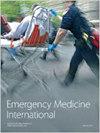利用循环统计进行蛛网膜下腔出血发病模式分析
IF 0.8
4区 医学
Q3 EMERGENCY MEDICINE
引用次数: 0
摘要
有关疾病生物节律的知识不仅有助于了解疾病的病理生理学,还能帮助医疗服务政策制定者和急诊科主任有效地分配资源。动脉瘤性蛛网膜下腔出血(SAH)的发病率和死亡率都很高。蛛网膜下腔出血的发病率与患者的相关因素有关,如动脉瘤的特征、吸烟和高血压。有研究表明,动脉瘤性 SAH 的发病率在很长一段时间内似乎呈周期性变化。然而,关于昼夜节律、季节和月经周期等时间生物学因素对 SAH 发生的影响,文献中的说法并不一致。在本研究中,我们采用循环统计方法,重点分析了 SAH 的时间模式(次昼夜节律)。我们的目的是研究 SAH 的发生是否存在循环模式,如果存在,是否可以根据现有文献将其与已知的时间模式联系起来。我们的研究并不支持动脉瘤性蛛网膜下腔出血发生在365天(包括特定的平日、满月、春分和夏至)特定长度周期中任何一天的观点。因此,我们发现蛛网膜出血发病率与时间没有关系。建议使用类似的循环统计方法在更大的人群中进行研究。本文章由计算机程序翻译,如有差异,请以英文原文为准。
Subarachnoid Haemorrhage Incidence Pattern Analysis with Circular Statistics
Knowledge about biological rhythms of diseases may not only help in understanding the pathophysiology of diseases but can also help health service policy makers and emergency department directors to allocate resources efficiently. Aneurysmal subarachnoid haemorrhage (SAH) has high rates of morbidity and mortality. The incidence of SAH has been attributed to patient-related factors such as characteristics of aneurysms, smoking, and hypertension. There are studies showing that the incidence of aneurysmal SAH appears to behave in periodic fashions over long time periods. However, there are inconsistencies in the literature regarding the impact of chronobiological factors such as circadian, seasonal, and lunar cycle factors on the occurrence of SAH. In this study, we focused on the analysis of a temporal pattern of SAH (infradian rhythms) with a novel approach using circular statistical methods. We aimed to see whether there is a circular pattern for the occurrence of SAH at all and if so, whether it can be related to known temporal patterns based on available literature. Our study did not support the notion that aneurysmal subarachnoid haemorrhages occur on any specific day in a cycle with specific lengths up to 365 days including specific weekdays, full moon, equinoxes, and solstices. Hence, we found no relationship between SAH incidence and timing. Study in larger populations using similar circular statistical methods is suggested.
求助全文
通过发布文献求助,成功后即可免费获取论文全文。
去求助
来源期刊

Emergency Medicine International
EMERGENCY MEDICINE-
CiteScore
0.10
自引率
0.00%
发文量
187
审稿时长
17 weeks
期刊介绍:
Emergency Medicine International is a peer-reviewed, Open Access journal that provides a forum for doctors, nurses, paramedics and ambulance staff. The journal publishes original research articles, review articles, and clinical studies related to prehospital care, disaster preparedness and response, acute medical and paediatric emergencies, critical care, sports medicine, wound care, and toxicology.
 求助内容:
求助内容: 应助结果提醒方式:
应助结果提醒方式:


